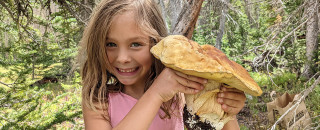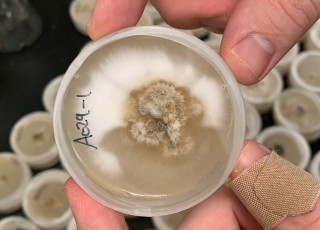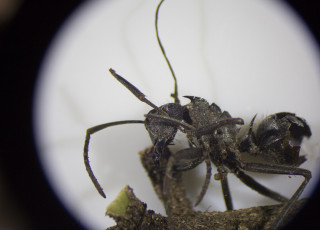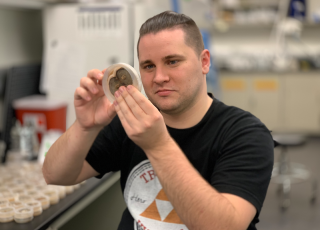Life is short, eat good mushrooms
By Bryn Dentinger
Have you ever wondered what mushrooms are in that “wild mushroom” sauce or soup or whatever? I have. In fact, I have a reputation for being that annoying customer who asks servers at restaurants “do you know what kinds of mushrooms are in this?” (or, probably even more absurdly, “do you know where these mushrooms are from?”).
You see, I am a forager, especially of wild mushrooms (if I had expertise in anything, I guess you could say they would be it), and a rather picky one. Simply edible is not an adequate descriptor for me. And if it is advertised as wild, I have particular expectations (apart from the basic expectation that it won’t make me sick!). Number one is that it be truly wild. Number two that it be foraged locally and sustainably (a tall order, I know, and one I am evidently willing to compromise on, with limits). And number three, that it actually tastes good.
Now, I realize that this latter criterion is rather subjective, but I would argue that there is a common palate we can all agree on, including flavor and texture. Sure, the margins of this palate are where things can get exciting – and wild mushrooms are no strangers to marginalization – but there are limits to flavors and textures that can rarely be breached with general appeal. This is all to say that in my opinion, most wild mushrooms are not worth eating under normal circumstances. Life is short, eat good mushrooms.
I have frequently encountered dishes at restaurants claiming to contain wild mushrooms that instead consist of cultivated varieties that are not the typical white “button” mushroom. Mushrooms like oysters (Pleurotus spp.), shiitake (Lentinula edodes), and even (gasp!) portabella (a strain of the white button mushroom, Agaricus bisporus) are common stand ins.
In this case “wild” simply means, “not white button mushrooms,” and while the different flavors and textures offered by these species is an improvement, they still lack the umami of porcini, the pizazz of a black trumpet, the otherworldliness of a matsutake. But these truly wild mushrooms are expensive and available only during certain times of year because they cannot be cultivated – many wild mushrooms that we value so highly are obligate symbionts of trees in a partnership known as mycorrhizae (mycor- means fungus and -rhizae means roots), where the fungus envelops the tree’s roots like a glove and exchanges soil nutrients and water for sugar the tree makes through photosynthesis.
Although many have tried, humans haven’t quite cracked the code on this intimate and complex relationship, and the mushrooms can’t yet be cultivated without their host. So, truly wild mushrooms are expensive and difficult to scale up for food producers, spurring them to turn to more reliable and cost-effective alternatives. Which is fine, but why call them “wild”?
My lab researches fungal diversity around the world, especially the mushrooms and allies, which brings us to far off places in search of new species. But because the Fungi are so poorly known (estimates range from 2.2 to 12 million species worldwide, but only about 5 to 8% have been documented), sometimes we don’t need to travel far to find new ones. In fact, a study we published in 2014 reported three new species of edible porcini from a packet purchased at a London grocer (I was living in London at the time) (Dentinger & Suz 2014).
So, when an undergraduate student came to me in 2018 to pursue an independent research project in my lab, I thought, why not look at more “wild mushroom” food products that are readily available to find out what actually is in them? He, along with one of my PhD students, ran with it, and was able to apply newly developed DNA sequencing techniques to figure out the mushrooms in 16 different food products that you can purchase right off the shelf at your local supermarket or from a, um, very large online retailer, from pasta sauce to packets of dried mushrooms.
What they found was quite revealing, and in a few cases alarming (Cutler II et al. 2021). For starters, most food products had ingredient labels that were either obscure with regards to the species of mushroom in them or were outright misleading. Second, perhaps not surprisingly, the typically cultivated stand ins were masquerading as “wild” in many of the products. Third, when truly wild mushrooms were present, they were mostly of inferior species known as “Slippery Jacks” (Suillus spp.), distant cousins of porcini with slimy caps that have established themselves all over the world wherever people have introduced pine trees (they are almost exclusively pine symbionts).
These mushrooms are harvested from the wild en masse in places worldwide, such as throughout South America, and exported for use in foods in the US and elsewhere. They are common in Utah near conifers when there is adequate moisture, but they are distinctly unremarkable for a meal (I don’t know anyone that regularly collects them for the table, and if they do, they are certainly never excited about it!). Finally, and most alarmingly, in a few packets of dried mushrooms, we found species that have been documented to cause serious poisoning in people (including fatalities!). One packet contained a variety of truly wild mushrooms, some of which we could not put names on and may represent new species, all of them belonging to taxa known only from Asia. These mushrooms are harvested in the wild in Yunnan, China, a major source of wild-harvested mushrooms globally (in fact, more than 50% of porcini sold in Italy now comes from China; Dentinger & Suz 2014). And if you wanted to, you can still order this product from the large online retailer today (I did notify them of my findings in 2019, but the product was never removed; it was even being promoted at one point!).
This is not to say that all food producers claiming to sell “wild mushrooms” in their products are committing fraud. Some of the products we tested were accurately labeled and did contain truly wild, high-value edible mushrooms. But as a consumer trying to navigate the quagmire of less than transparent labels and ambiguous or dubious claims, our study does not exactly bolster confidence. For me, my picky foraging is no longer just limited to the forest, but will extend to the supermarket as well.
Bryn Dentinger is NHMU's curator of mycology and an associate professor of biology at the University of Utah. NHMU is part of the University of Utah in Salt Lake City. Our mission is to illuminate the natural world and the place of humans within it. In addition to housing outstanding exhibits for the public, NHMU is a research museum. Learn more.



